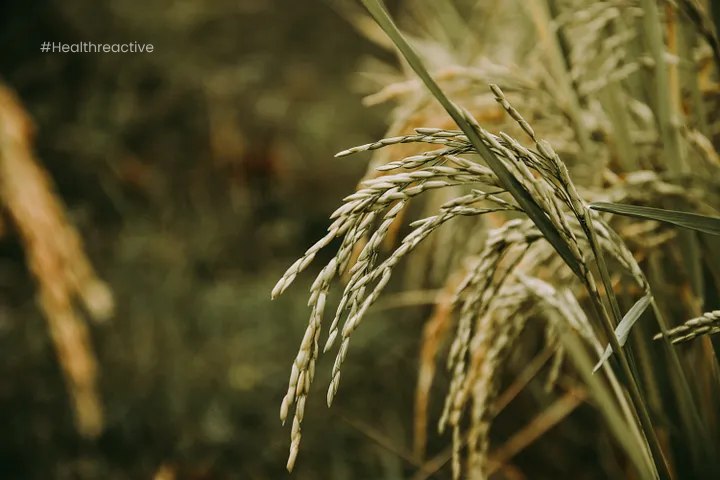In the world of Ayurveda, a profound and holistic system of medicine that originated in ancient India, the understanding of food and its classification is of utmost importance. Cereals hold a special place in the Ayurvedic diet, and among them, rice shines as a prominent and cherished grain. In this article, we will delve into the Ayurvedic perspective on cereals, with a particular focus on rice and two of its noteworthy types: Sali and Vreehi.

7 interesting facts about Rice :
Rice, scientifically known as Oriza sativa, is one of the world’s oldest cultivated crops, dating back over 5,000 years.
- There are thousands of rice varieties, each with unique flavours, textures, and culinary uses.
- Rice is a staple food for more than half of the global population, especially in Asia.
- It is not only used in savoury dishes but also in delightful desserts like rice pudding and rice cakes.
- In Ayurveda, rice is considered a sattvic food, promoting mental clarity and balance.
- Rice paddies provide a habitat for diverse plant and animal species, acting as natural water purifiers.
- Rice holds immense cultural significance, being used in religious ceremonies and symbolizing abundance and prosperity in various cultures.
Section 1:Ayurvedic Insights on Cereals:
- Learn why cereals hold significant importance in Ayurveda’s dietary principles?
- Understand the role of rice as a prominent cereal in Ayurvedic cuisine:
- Discover the connection between cereals and overall health in Ayurvedic philosophy:
Ayurveda recognizes cereals as a vital source of nutrition and energy. Cereals are categorized as “Annavarga”.In this group, “Sooka Dhanyas” are the group of grain-based foods, based on their qualities and effects on the doshas (bioenergetic forces). In the ancient scriptures, rice holds a sacred place. It is mentioned in Yajurveda and Atharvaveda. Unhusked rice mixed with pounded rice is used in religious ceremonies. Rice has been a staple food for over 12,000 years, and in 2004, the United Nations celebrated it as the International Year of Rice. Understanding the Ayurvedic properties of different cereals helps us make informed dietary choices.
The Concept of Rice According to Ayurveda:
Rice, known as Sali dhanya in Ayurveda, is one of the most balanced and easily digestible grains. It is sweet in taste and cooling in nature, making it suitable for all doshas when cooked appropriately. Ayurveda emphasizes the importance of consuming freshly harvested rice for optimal benefits.
Section 2: The Concept of Rice According to Ayurveda
Uncover Ayurveda’s perspective on rice and its unique qualities
Explore the taste, nature, and benefits of rice as per Ayurvedic texts
Gain insights into the importance of using freshly harvested rice in Ayurvedic cooking
Ayurveda recognizes the significance of food in maintaining optimal health and balance. Cereals, as a key component of the Ayurvedic diet, provide essential nutrients, energy, and nourishment to the body. Among these cereals, rice has emerged as a staple that holds a special place in Ayurveda’s dietary recommendations and therapeutic practices.
Ayurvedic Properties of Rice:Shali
In the realm of Ayurveda, shali rice reigns supreme. Its sweet taste and cooling nature captivate the senses. Easily digested, it nourishes the body and promotes vitality. From ancient warriors to modern seekers of wellness, shali rice stands as a testament to Ayurvedic power. Embrace its magic and savor its gifts.his variety of rice is known for its sweet taste and cooling effect on the body. It is easily digestible and offers nourishment, making it suitable for various dosha types. Additionally, shali rice is believed to promote strength, enhance vitality, and support healthy digestion. Its unique properties make it a prized ingredient in Ayurvedic cuisine and therapeutic preparations.
Section 3: Ayurvedic Properties of Rice
Discover the sattvic nature of rice and its impact on mental well-being
Learn about the nutritional composition of rice and its role in providing essential nutrients
Understand how rice aids digestion and soothes the digestive system
- Sattvic Nature: Rice possesses a sattvic quality, promoting clarity, calmness, and mental balance.
- Nutrient-rich: Rice provides essential nutrients such as carbohydrates, B-vitamins, and minerals like magnesium and selenium.
- Digestive Aid: It aids in digestion, relieves constipation, and soothes the digestive system.
- Cooling Effect: Rice has a cooling effect on the body, making it beneficial during hot weather or for individuals with Pitta dosha imbalances.
- Energy Booster: The easily digestible carbohydrates in rice provide sustained energy throughout the day.
Section 4:main two types of Rices in Ayurveda:Sali and Vreehi
Explore the distinct characteristics and benefits of Sali and Vreehi rice varieties
Learn which doshas are supported by each rice type
Gain tips on how to incorporate these rice varieties into your Ayurvedic diet
- Sali: Sali rice is a unique variety that undergoes a special parboiling process before milling, preserving most of its nutrients. It is rich in fiber and has a nutty flavour. Sali rice is known for its ability to balance Vata and Pitta doshas.
- Vreehi: Vreehi rice, also known as “wild rice” or “Brihat,” is a longer-grain variety. It is nutritious and has a slightly astringent taste. Vreehi rice is believed to balance Kapha dosha and is suitable for Kapha-related imbalances.
Modern Correlation to Oryza Sativa and Ayurvedic Sali Dhanya:
Oryza sativa, the scientific name for rice, is commonly associated with the Ayurvedic concept of Sali Dhanya. Sali Dhanya refers to specific varieties of rice used in Ayurvedic preparations, such as medicated gruel (kheer) and herbal decoctions. These preparations provide targeted nourishment and therapeutic benefits, supporting overall health and well-being.
Incorporate the timeless wisdom of Ayurveda into your daily life with a deeper understanding of rice, sali, vreehi, and the transformative power of cereals. Let these ancient grains nourish your body, mind, and spirit for a balanced and vibrant life.